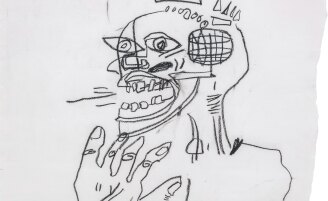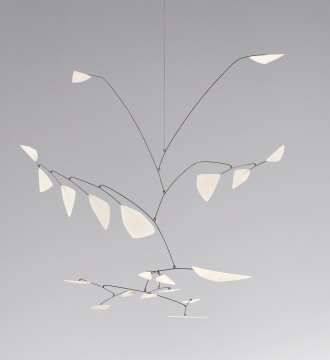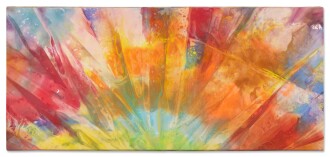David Hockney, ‘Terrace Hollywood Hills House with Banana Tree’
Terrace Hollywood Hills House with Banana Tree from 1982 exemplifies David Hockney’s California period, blending vibrant color, fragmented perspective and theatrical composition to depict the interplay of indoor and outdoor life in Los Angeles. Influenced by stage design, Cubism and artists like Matisse, the painting merges personal memory with formal experimentation. Lush vegetation, bold architectural forms and Hockey’s signature pool imagery evoke both the physical landscape and emotional essence of Southern California. A highlight of the lauded exhibition Hockney Paints the Stage from 1983, the work encapsulates Hockney’s modernist vision and enduring fascination with light, space, and visual storytelling.
Alexander Calder, ‘20 White in 20 Inches’
20 White in 20 Inches is a masterful example of Alexander Calder’s kinetic sculpture, created during a pivotal decade of global recognition. Featuring 20 white elements within a compact vertical frame, the mobile exemplifies Calder’s innovation through motion, minimalism and spatial harmony. The present work has never before been seen, having remained in the family of the original owner, who commissioned the work directly from Alexander Calder. Echoing his Snow Flurry series and drawing on the monochrome legacy of Malevich and Mondrian, the present work embodies Calder’s vision of sculpture as dynamic and atmospheric, reinforcing his legacy as a pioneer of motion in modern art.
Sam Gilliam, ‘Ray II’
Sam Gilliam’s Ray II exemplifies his groundbreaking fusion of painting and sculpture through his signature beveled-edge technique. Created in 1970, the work explodes with vibrant, prismatic color and three-dimensional presence, challenging traditional expectations of African American art and the flatness of the canvas. Using poured, folded acrylics, Gilliam harnessed gravity and gesture to create luminous, tactile surfaces. Ray II transforms painting into a spatial experience, immersing viewers in a dynamic interplay of color, form and movement – affirming Gilliam’s legacy as a pioneering figure in postwar abstraction and a radical innovator of the medium.
Avery Singer, ‘Kundry’
Avery Singer’s Kundry reimagines Richard Wagner’s mythic heroine from the 19th-century opera Parsifal as a luminous, sword-wielding avatar, suspended in a digitally rendered grid. Fusing 3D modeling software with airbrushed precision, Singer blurs the lines between painting and technology, illusion and material. A highlight of her 2018 solo show Days of the Week (Computer Pain), Kundry exemplifies Singer’s pioneering aesthetic – where classical archetypes and digital artifice converge to redefine narrative in the age of the screen.
George Condo, ‘The Endless Journey’
George Condo’s The Endless Journey from 2022 is a monumental example of the artist’s style of psychological Cubism, blending abstraction and figuration to depict the complexities of the human mind. The painting’s dense, chaotic forms and jarring color palette evoke emotional and perceptual instability. With its hallucinatory quality, the work reflects Condo’s ongoing examination of identity, perception and internal states. The title suggests an unresolved, perpetual transformation, while the fragmented figure speaks to the tensions between order and chaos. The Endless Journey represents Condo’s mastery in blending historical influences with contemporary psychological depth.





